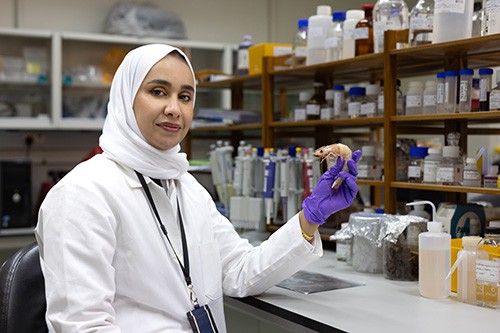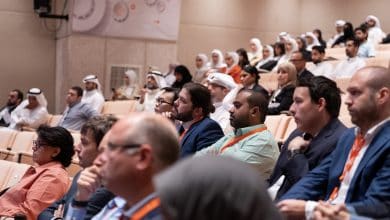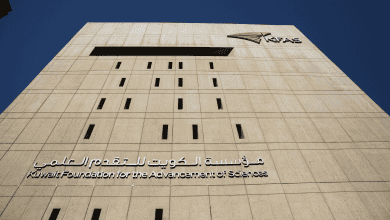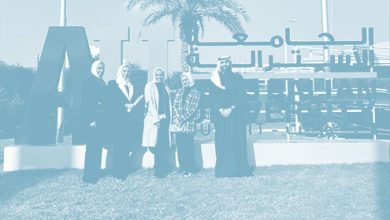The Future of Kuwaiti Aquaculture
Thanks to new research done on a semi-commercial scale, the country is one step closer to establishing an inland shrimp farming industry

يجعل الصيف الحار والتربة الرملية الكويت غير مناسبة للزراعة. ومع ذلك، فإن مناخ البلاد مناسب تمامًا لأشكال معينة من تربية الأحياء المائية، بما في ذلك الروبيان. ومن هذا المنطلق، بدأ باحثون في معهد الكويت للأبحاث العلمية بدراسة تربية الأحياء المائية في سبعينات القرن العشرين. ويعتقد المعهد أن توسيع نطاق استزراع الروبيان في الكويت ربما يحسِّن الأمن الغذائي في البلاد، وينوِّع مصادر دخل أصحاب المزارع المحليين.
Early research on shrimp farming at KISR concerned coastal farms, where shrimp are raised in their natural saltwater habitat. However, Kuwait has limited coastline real estate, and most farmers operate on inland properties, so in 2015, KISR began exploring opportunities for inland shrimp farming. “We wanted to create opportunities for the small- to medium farms located in the inland area,” said Sherain Al-Subiai, an associate research scientist in the mariculture and fisheries department at KISR.
Operating inland shrimp farms presents a host of challenges. The most significant is that groundwater is ill-suited to shrimp farming because it lacks certain elements of seawater that shrimp depend on to survive. This is the issue that Al-Subiai and her colleagues at KISR have been working to overcome through years of research and experimentation. “There are many elements in seawater, which must be looked at one by one,” said Al-Subiai. By adjusting things like magnesium, potassium, and sodium, researchers can make groundwater mimic saltwater and thus create a suitable habitat to foster shrimp far from the coast.
أبحاث وفق نطاق جديد
حقق فريق الاستزراع المائي في معهد الكويت للأبحاث العلمية أكبر قفزة في عام 2019 عندما قدمت لهم مؤسسة الكويت للتقدم العلمي منحة مدتها عامان للمساعدة على تمويل موقع بحثي جديد وإجراء تجارب على نطاق شبه تجاري. قالت السبيعي “نجري عادة تجاربنا على نطاق صغير في المعهد. لكنني أردت الحصول على بيانات يمكن تطبيقها على القطاع التجاري، ولهذا كنت بحاجة إلى العمل على نطاق شبه تجاري”.
The team established their new research site at Kabd, about 40 kilometers outside Kuwait City and at least 30 kilometers from the nearest coast. It has both outdoor and indoor facilities. The indoor facility hosts a pair of circular tanks where shrimp live during the nursery stage, after they have hatched and before they are large enough to be moved into ponds where they can grow to their full size. There are also three 75-square-meter flow-through systems or raceways located indoors, where shrimp can be cultured at a high density. Outside, there are a pair of earthen ponds, sized 1,500 square meters, also used during the grow-out phase.
Funding from KFAS also allowed researchers to purchase supplies needed to operate the research, including imported shrimp feed, imported shrimp larvae, and various test kits to monitor water quality at the research site and ensure the shrimp were free from diseases. “Without KFAS’ support, this project would not have been possible,” said Al-Subiai.
When the research team began its work, the survival rate of shrimp, meaning how many shrimps stay alive until they’re large enough to be harvested, was less than 20 percent. “Through the project, we increased the survival rate to 72 percent,” she said. “It is a massive increase.” The new survival rate is also much closer to the rate achieved on saltwater farms, which usually measures about 80 percent. Other measurements of success are also on par with what researchers expect on an inland shrimp farm.
The future of inland shrimp farming After two years of KFAS-funded research at Kabd, Al-Subiai is preparing her findings for publication. The results will be published in a major aquaculture journal. For the next stage of their research, Al-Subiai said the team plans to study minor elements, like zinc and copper, which can affect how large the shrimp grow before harvest. The team is also looking for alternatives to replace the expensive salt they add to their water with something less costly and more environmentally friendly.
In the future, this research, Al-Subiai said, could also be applied to farming species of shrimp native to Kuwait. Using native species would decrease the need to import shrimp larvae, making shrimp farming more profitable. The native species are also more popular among local consumers.
A final obstacle to scaling up inland shrimp farming in Kuwait is the lack of know-how among local farmers, but Al-Subiai and her team are addressing this too. With on-site training courses at the Kabd research site, the KISR team prepares farmers to become the first generation of inland shrimp farmers in Kuwait. They offer one training course for beginners and one for those with existing knowledge each year. Course objectives include ensuring farmers understand the infrastructure of an inland shrimp farm, know how to test and adjust water quality, and can diagnose and treat common diseases in shrimp.
With these next steps for the research team and growing interest in training courses each year, the future of shrimp farming in Kuwait is promising. “If you had asked me five years back, I would have said it was impossible to culture shrimp inland,” said Al-Subiai. Today, however, thanks to the determination of the research team at KISR and funding from KFAS, she said, “It is possible, and we can do it in Kuwait.”
By Marianne Dhenin




